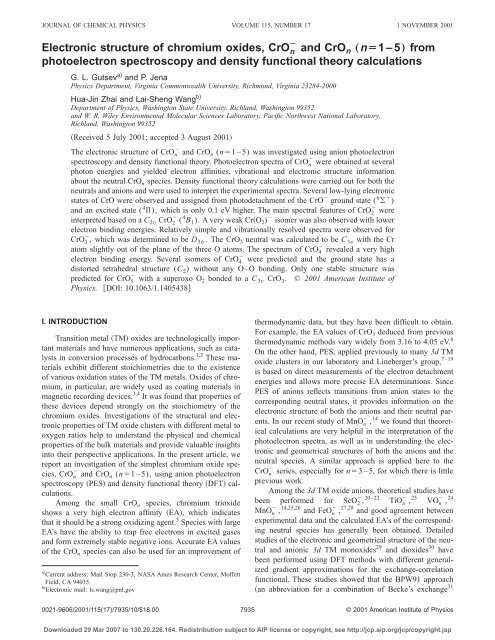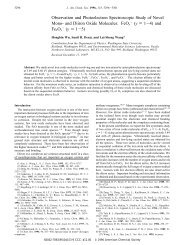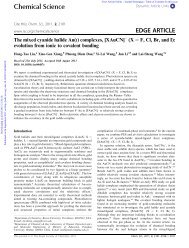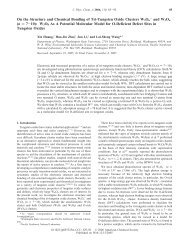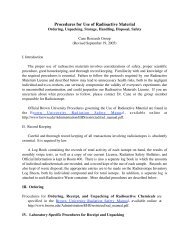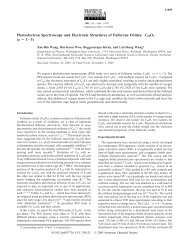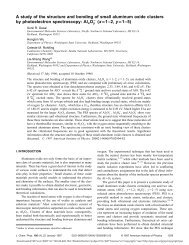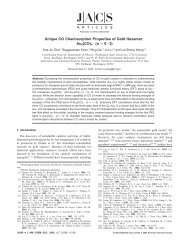Electronic structure of chromium oxides, CrOn - Washington State ...
Electronic structure of chromium oxides, CrOn - Washington State ...
Electronic structure of chromium oxides, CrOn - Washington State ...
Create successful ePaper yourself
Turn your PDF publications into a flip-book with our unique Google optimized e-Paper software.
JOURNAL OF CHEMICAL PHYSICS VOLUME 115, NUMBER 17 1 NOVEMBER 2001<strong>Electronic</strong> <strong>structure</strong> <strong>of</strong> <strong>chromium</strong> <strong>oxides</strong>, CrO n À and CrO n „nÄ1–5… fromphotoelectron spectroscopy and density functional theory calculationsG. L. Gutsev a) and P. JenaPhysics Department, Virginia Commonwealth University, Richmond, Virginia 23284-2000Hua-Jin Zhai and Lai-Sheng Wang b)Department <strong>of</strong> Physics, <strong>Washington</strong> <strong>State</strong> University, Richland, <strong>Washington</strong> 99352and W. R. Wiley Environmental Molecular Sciences Laboratory, Pacific Northwest National Laboratory,Richland, <strong>Washington</strong> 99352Received 5 July 2001; accepted 3 August 2001The electronic <strong>structure</strong> <strong>of</strong> CrO n and CrO n (n1 – 5) was investigated using anion photoelectronspectroscopy and density functional theory. Photoelectron spectra <strong>of</strong> CrO n were obtained at severalphoton energies and yielded electron affinities, vibrational and electronic <strong>structure</strong> informationabout the neutral CrO n species. Density functional theory calculations were carried out for both theneutrals and anions and were used to interpret the experimental spectra. Several low-lying electronicstates <strong>of</strong> CrO were observed and assigned from photodetachment <strong>of</strong> the CrO ground state ( 6 )and an excited state ( 4 ), which is only 0.1 eV higher. The main spectral features <strong>of</strong> CrO 2 wereinterpreted based on a C 2v CrO 2 ( 4 B 1 ). A very weak CrO 2 ) isomer was also observed with lowerelectron binding energies. Relatively simple and vibrationally resolved spectra were observed forCrO 3 , which was determined to be D 3h . The CrO 3 neutral was calculated to be C 3v with the Cratom slightly out <strong>of</strong> the plane <strong>of</strong> the three O atoms. The spectrum <strong>of</strong> CrO 4 revealed a very highelectron binding energy. Several isomers <strong>of</strong> CrO 4 were predicted and the ground state has adistorted tetrahedral <strong>structure</strong> (C 2 ) without any O–O bonding. Only one stable <strong>structure</strong> waspredicted for CrO 5 with a superoxo O 2 bonded to a C 3v CrO 3 . © 2001 American Institute <strong>of</strong>Physics. DOI: 10.1063/1.1405438I. INTRODUCTIONTransition metal TM <strong>oxides</strong> are technologically importantmaterials and have numerous applications, such as catalystsin conversion processes <strong>of</strong> hydrocarbons. 1,2 These materialsexhibit different stoichiometries due to the existence<strong>of</strong> various oxidation states <strong>of</strong> the TM metals. Oxides <strong>of</strong> <strong>chromium</strong>,in particular, are widely used as coating materials inmagnetic recording devices. 3,4 It was found that properties <strong>of</strong>these devices depend strongly on the stoichiometry <strong>of</strong> the<strong>chromium</strong> <strong>oxides</strong>. Investigations <strong>of</strong> the structural and electronicproperties <strong>of</strong> TM oxide clusters with different metal tooxygen ratios help to understand the physical and chemicalproperties <strong>of</strong> the bulk materials and provide valuable insightsinto their perspective applications. In the present article, wereport an investigation <strong>of</strong> the simplest <strong>chromium</strong> oxide species,CrO n and CrO n (n1 – 5), using anion photoelectronspectroscopy PES and density functional theory DFT calculations.Among the small CrO n species, <strong>chromium</strong> tri<strong>oxides</strong>hows a very high electron affinity EA, which indicatesthat it should be a strong oxidizing agent. 5 Species with largeEA’s have the ability to trap free electrons in excited gasesand form extremely stable negative ions. Accurate EA values<strong>of</strong> the CrO n species can also be used for an improvement <strong>of</strong>a Current address: Mail Stop 230-3, NASA Ames Research Center, M<strong>of</strong>fettField, CA 94035.b <strong>Electronic</strong> mail: ls.wang@pnl.govthermodynamic data, but they have been difficult to obtain.For example, the EA values <strong>of</strong> CrO 3 deduced from previousthermodynamic methods vary widely from 3.16 to 4.05 eV. 6On the other hand, PES, applied previously to many 3d TMoxide clusters in our laboratory and Lineberger’s group, 7–19is based on direct measurements <strong>of</strong> the electron detachmentenergies and allows more precise EA determinations. SincePES <strong>of</strong> anions reflects transitions from anion states to thecorresponding neutral states, it provides information on theelectronic <strong>structure</strong> <strong>of</strong> both the anions and their neutral parents.In our recent study <strong>of</strong> MnO n , 14 we found that theoreticalcalculations are very helpful in the interpretation <strong>of</strong> thephotoelectron spectra, as well as in understanding the electronicand geometrical <strong>structure</strong>s <strong>of</strong> both the anions and theneutral species. A similar approach is applied here to theCrO n series, especially for n3 – 5, for which there is littleprevious work.Among the 3d TM oxide anions, theoretical studies havebeen performed for ScO 2 , 20–22 TiO n , 23 VO n , 24MnO n , 14,25,26 and FeO n , 27,28 and good agreement betweenexperimental data and the calculated EA’s <strong>of</strong> the correspondingneutral species has generally been obtained. Detailedstudies <strong>of</strong> the electronic and geometrical <strong>structure</strong> <strong>of</strong> the neutraland anionic 3d TM mon<strong>oxides</strong> 29 and di<strong>oxides</strong> 30 havebeen performed using DFT methods with different generalizedgradient approximations for the exchange-correlationfunctional. These studies showed that the BPW91 approachan abbreviation for a combination <strong>of</strong> Becke’s exchange 310021-9606/2001/115(17)/7935/10/$18.00 7935© 2001 American Institute <strong>of</strong> PhysicsDownloaded 29 Mar 2007 to 130.20.226.164. Redistribution subject to AIP license or copyright, see http://jcp.aip.org/jcp/copyright.jsp
7936 J. Chem. Phys., Vol. 115, No. 17, 1 November 2001 Gutsev et al.and Perdew–Wangs’ correlation 32 functionals provides similarresults as the BLYP one Becke’s exchange 31 and Lee–Yang–Parr correlation 33 , which are generally superior tothose obtained by a hybrid Hartree–Fock–DFT B3LYPapproach. 34The current work is aimed at understanding the electronicand geometrical <strong>structure</strong>s <strong>of</strong> the mono<strong>chromium</strong> <strong>oxides</strong>pecies CrO n and CrO n (n1 – 5) using a combinedexperimental and theoretical study. Among these five <strong>oxides</strong>pecies, CrO and CrO 2 have been previously studied byPES at a lower photon energy. 15,16 Several photon energiesare used in the current work because higher photon energiesare necessary for oxygen-rich species, which generally havevery high EA’s. Geometrical <strong>structure</strong>s for both the neutraland negatively charged clusters are optimized at the BPW91level. Electron detachment energies were also calculatedfrom the anions and were used to help interpret the experimentalPES data.II. EXPERIMENTAL AND COMPUTATIONAL DETAILSA. Experimental methodOur experiments were performed with a magnetic bottletime-<strong>of</strong>-flight photoelectron spectrometer, which has beendescribed in detail elsewhere. 35,36 The apparatus is composed<strong>of</strong> a laser vaporization source, a time-<strong>of</strong>-flight mass spectrometerand a magnetic bottle time-<strong>of</strong>-flight electron analyzer.Chromium atoms, generated from laser vaporization <strong>of</strong>a pure Cr target, reacted with O 2 seeded in a helium carriergas, producing a series <strong>of</strong> oxide clusters. The clusters entrainedin the carrier gas underwent a supersonic expansionand collimated by a skimmer. Anions from the collimatedbeam were extracted perpendicularly into a time-<strong>of</strong>-flightmass analyzer. Desired anions were mass-selected and subsequentlydecelerated before crossing a detachment laserbeam. Both a Q-switched Nd:YAG laser 532 nm–2.331 eV,355 nm–3.496 eV, and 266 nm–4.661 eV and an ArF excimerlaser were used for photodetachment in the current experiments.The energy resolution <strong>of</strong> our apparatus was betterthan 30 meV for 1 eV electrons, as calibrated with Cu . Dueto the dependence <strong>of</strong> the resolution on electron kinetic energies,lower photon energy spectra yielded better resolveddata. But high photon energies were necessary to investigatespecies with high EA’s, as well as yielding more excitedstates <strong>of</strong> the neutral species.B. Theoretical proceduresOur calculations were performed using an approachwhere linear combinations <strong>of</strong> atomic orbitals constitute oneelectronmolecular orbitals MO-LCAO. The many-electronpotential was constructed using DFT with a generalized gradientapproximation for the exchange-correlation functional.A combination <strong>of</strong> Becke’s exchange 31 and Perdew–Wangs’correlation 32 functionals, referred to as BPW91, was used asimplemented in GAUSSIAN 94. 37 For the atomic orbitals, weused the standard 6-311G* basis (Cr:15s11p4d1 f /10s7p4d1 f and O:13s6p1d/5s4p1d) due to Wachtersand Hay. 38,39 Geometry optimizations were carried out by thesteepest descent method until the gradient forces fell belowthe threshold value <strong>of</strong> 310 4 au. Analytical harmonic frequencycalculations were performed subsequently to confirmthat the optimized geometrical configurations correspondedto stationary states.Density functional theory is valid for the lowest energystates in each particular spatial and spin symmetry. 40–43Extensive optimizations, beginning with different spatialconfigurations for each spin multiplicity for both the CrO nand CrO n series, were performed to ensure that the groundstateconfigurations were identified unambiguously. Comparison<strong>of</strong> the computed properties with experimental datawas made to further verify our theoretical results. Verticalbinding energies (E b,i ) or vertical detachment energiesVDE’s, which correspond to band maxima in photodetachmentspectra, are due to a sudden detachment <strong>of</strong> an electronfrom an anion A to the corresponding neutral parent insome particular state N i . The quantity E b,i can be evaluatedat the equilibrium ground-state geometry R A <strong>of</strong> the anion as:E b,i E tot N i ,R A E tot A,R A .With the present approach, only two transitions to neutralstates N k (k1 and 2 can be computed directly. If theground-state spin multiplicity <strong>of</strong> the anion is 2S1M,then we can compute the energies <strong>of</strong> electron detachmentresulting in the two lowest neutral states with spin multiplicities2S1M1.In order to evaluate transition energies to other neutralstates, one could apply an approximate formula, which weused to assign features in the PES spectra <strong>of</strong> the MnO nanions, 141AE b, j E tot N kn ,R A E tot A,R A HOMO,n A j,n , 2where k(1 or2 denotes the neutral states accessible fromthe anion ground state as in Eq. 1, j2, n or denotesAthe spin representation, and j,n are eigenvalues to theAKohn–Sham orbitals <strong>of</strong> the anion ground state, HOMO,n isthe eigenvalue to the highest occupied molecular orbital inthe n spin representation.Adiabatic detachment energies (A ad ), corresponding toremoval <strong>of</strong> an electron from the ground state <strong>of</strong> the anion tostates <strong>of</strong> the neutral at their respective equilibrium geometries,are given by the differences in total energies <strong>of</strong> theneutral and anion states:A ad E tot N,R N Z N E tot A,R A Z A E el E nuc ,where R N and R A denote ground-state equilibrium geometries<strong>of</strong> a neutral molecule N and its anion A, respectively.Zero-point energies Z were computed within the harmonicapproximation. While values <strong>of</strong> E b,i correspond toband maxima in a PES spectrum, the A ad values are to bededuced from the thresholds <strong>of</strong> PES bands or the 0–0 transitions<strong>of</strong> vibrationally resolved bands. The A ad Value obtainedfor the ground-state transition corresponds to the EA<strong>of</strong> the neutral molecule. Electron affinity measures the totalenergy gain <strong>of</strong> a system due to attachment <strong>of</strong> an extra electronand represents an important thermodynamic quantity.3Downloaded 29 Mar 2007 to 130.20.226.164. Redistribution subject to AIP license or copyright, see http://jcp.aip.org/jcp/copyright.jsp
J. Chem. Phys., Vol. 115, No. 17, 1 November 2001 <strong>Electronic</strong> <strong>structure</strong> <strong>of</strong> <strong>chromium</strong> <strong>oxides</strong>7937FIG. 1. Photoelectron spectra <strong>of</strong> CrO at a 532 nm 2.331 eV, b 355 nm3.496 eV, andc 266 nm 4.661 eV. HB stands for hot bands. * indicatestransitions from an excited state <strong>of</strong> CrO .In order to estimate the thermodynamic stability <strong>of</strong> the<strong>chromium</strong> <strong>oxides</strong>, we also computed fragmentation energiesas the differences in total energies <strong>of</strong> fragments F i formed ina particular decay channel and the total energy <strong>of</strong> an initialcompound M:D e M iE tot F i E tot M , 4where the zero-point energy corrections are neglected becausethey are relatively small.III. EXPERIMENTAL AND THEORETICAL RESULTSA. Experimental resultsFigure 1 shows the spectra <strong>of</strong> CrO measured at threephoton energies. Well-resolved bands with vibrational <strong>structure</strong>swere obtained. Many excited-state features were observedin the 266 nm spectrum Fig. 1c, but they could notbe clearly resolved and assigned beyond 3.5 eV owing tolimited resolution and spectral congestion. A high resolutionspectrum <strong>of</strong> CrO obtained at 351 nm was reported previouslyby Lineberger et al., 15 but no detailed assignment wasgiven. Generally, the current data agree well with the previoushigh resolution spectrum, with minor variations in relativeintensities, due to the different experimental techniquesemployed the current experiment is angle-integrated andmeasures electrons from all 4 solid angles. In particular,the 2.13 eV feature ( 5 ) is much stronger than the previousspectrum, whereas the 1.82 eV vibrational progression( 3 *) appears to be weaker but with stronger hot bandtransitions HB. Two more additional and relatively weakfeatures could also be identified from the current spectra at355 and 266 nm: the feature at 2.64 eV ( 3 *) whose intensitywas enhanced in the 266 nm spectrum and a vibrationalprogression starting at 3.03 eV ( 3 *). More transitions wereobserved in the 266 nm Fig. 1c, but could not be definitelyidentified due to limited spectral resolution and congestion.The assignments were made on the basis <strong>of</strong> our theoreticalcalculations, as discussed later. The observed statesare labeled in Fig. 1 * indicates transitions from an excitedanion and compared with the theoretical calculations inTable I. The observed detachment transitions and obtainedspectroscopic constants are given in Fig. 2.The spectra <strong>of</strong> CrO 2 , shown in Fig. 3, were obtained atthree detachment energies as well. The 355 nm spectrumFig. 3a was vibrationally resolved with the 0–0 transitionat 2.43 eV. There appears to be two vibrational progressions.The main progression has a vibrational spacing <strong>of</strong> about 900cm 1 , and the other progression has a spacing <strong>of</strong> about 220cm 1 . Very weak signals (X) were observed at 1.5 eV.These signals completely disappeared when the carrier gaswas seeded with N 2 O, instead <strong>of</strong> O 2 , as was the case for the193 nm spectrum Fig. 3c. The weak features were likelydue to a CrO 2 ) isomer, as discussed later. The 266 nmspectrum Fig. 3b revealed two more intense features Aand B, compared to the 355 nm spectrum. The broadness <strong>of</strong>these features indicates that there must be significant geometrychanges between the anions and the corresponding neutralstates or there might be overlapping and unresolved electronictransitions. At 193 nm, there seemed to be unresolvedfeatures throughout the higher energy side beyond feature B.The relative intensities <strong>of</strong> the first three detachment bands inthe 193 nm spectrum were changed compared to the 266 nmspectrum.The weak low-binding energy feature around 1.5 eVcompletely disappeared in the 193 nm spectrum because anN 2 O-seeded He carrier gas was used in this experiment.Similar behavior was observed in the 266 and 355 nm spectrataken under the same conditions. This feature is likelydue to a peroxo species CrO 2 ) , which is consistent withthe results <strong>of</strong> our previous DFT calculations performed foroxo, peroxo, and superoxo isomers <strong>of</strong> <strong>chromium</strong> dioxide andits anion. 30 The low EA <strong>of</strong> this isomer is also in agreementwith a general anticipation that a 3d-metal oxygen peroxocomplex MO 2 ) has a lower EA than the corresponding 3dmetaloxo complex OMO. 7 A higher resolution spectrum <strong>of</strong>CrO 2 obtained at 351 nm was previously reported byLineberger et al. 16 However, the 351 nm photon energy allowedonly the first detachment band to be observed. Thecurrent spectrum at 355 nm is consistent with the previousdata, although the previous spectrum showed a much broaderDownloaded 29 Mar 2007 to 130.20.226.164. Redistribution subject to AIP license or copyright, see http://jcp.aip.org/jcp/copyright.jsp
7938 J. Chem. Phys., Vol. 115, No. 17, 1 November 2001 Gutsev et al.TABLE I. Experimental Expt. and calculated vertical electron detachment energies eV from the two lowestlyingstates <strong>of</strong> CrO .ElectronconfigurationFinalstateBPW916-311G*BPW91Augmen. aBLYP6-311G*BLYPAugmen. aExpt.CrO 6 9 1 1 2 4 2→9 1 1 2 4 1 5 1.22 1.24 1.06 1.11 1.220.01→9 1 1 1 4 2 5 2.17 2.22 1.93 2.02 2.130.02→9 0 1 2 4 2 5 2.47 2.41 2.23 2.20 2.280.03→3 3 9 1 1 2 4 2 7 3.84 3.89 3.69 3.795 4.54 4.56 4.24 4.32→8 1 9 1 1 2 4 2 7 4.49 4.52 4.34 4.415 4.89 4.91 4.62 4.70CrO ( 4 )9 2 1 2 4 1 0.31 b 0.34 b 0.05 b 0.003 b 0.096 b→9 1 1 2 4 1 5 0.87 0.86 1.06 1.08 1.120.01→9 2 1 2 4 0 3 1.97 1.97 1.81 1.83 1.820.02→9 1 1 2 4 1 3 2.65 2.62 2.38 2.37 2.640.03→9 2 1 1 4 13 3.22 3.21 2.93 2.94 3.030.03or 3 →8 1 9 2 1 2 4 1 5 4.16 4.21 4.22 4.26→3 3 9 2 1 2 4 1 5 4.83 4.87 4.87 4.90a Basis Cr19s13p11d6 f is obtained by adding exponents intermediate between those <strong>of</strong> the standard6-311G* basis and five diffuse f-functions. For O, the standard 6-311G(3df) basis is used.b Energy in eV relative to the 6 state.Franck–Condon envelope for the X band, apparently due tointense hot band transitions.Figure 4 shows the spectra <strong>of</strong> CrO 3 taken at two photonenergies. The 266 nm spectrum Fig. 4a exhibited a wellresolvedvibrational progression with an average spacing <strong>of</strong>890 cm 1 . Two more well-separated and well-resolved bandsA and B were observed in the 193 nm spectrum Fig. 4b.The weak features might be due to vibrational <strong>structure</strong>s orpossible overlapping transitions as revealed from our theoreticalresults. The weak feature a to the left <strong>of</strong> the A featurewas due to a discrete detachment transition. As discussedlater, several transitions might have contributed to the B feature.Both CrO 4 and CrO 5 were found to have very highelectron detachment energies and their spectra could only beobserved at 193 nm, as shown in Fig. 5. Two well-resolvedand intense features were observed for CrO 4 Fig. 5a.There were also weak features tailing the lower energy sideFIG. 2. The observed detachment transitions from the two anionic states <strong>of</strong>CrO and the spectroscopic constants <strong>of</strong> CrO.FIG. 3. Photoelectron spectra <strong>of</strong> CrO 2 at a 355 nm, b 266 nm, and c193 nm 6.424 eV. The vertical lines in a indicate resolved vibrationalprogressions.Downloaded 29 Mar 2007 to 130.20.226.164. Redistribution subject to AIP license or copyright, see http://jcp.aip.org/jcp/copyright.jsp
J. Chem. Phys., Vol. 115, No. 17, 1 November 2001 <strong>Electronic</strong> <strong>structure</strong> <strong>of</strong> <strong>chromium</strong> <strong>oxides</strong>7939TABLE II. Observed vertical electron detachment energies VDE and spectroscopicconstants for CrO n and CrO n (n2 – 5) compared with theoreticalresults Theor. computed according to Eqs. 1 and 2.<strong>State</strong>Expt.VDE eV aTheor. bVib. freq. acm 1 CrO 2 X 5 B 2 1.506 1.37CrO 2 X 3 B 1 2.432 2.35 90080 c ;22040 dA 3 A 1 , 3 B 1 3.415 2.73B 5 A 2 , 3 A 2 4.255 4.265 A 1 , 3 B 1 , 5 B 1 4.5 4.66eCrO 3 X 1 A 1 3.662 3.61 89060a 1 A 2 4.612 4.42A 3 A 1 4.702 4.611 A 2 , 3 A 2 5.432 5.57, 5.75CrO 4 X 3 A 2 5.074 4.95A 1 A 6.043 6.13CrO 5 X 3 A 4.71 4.69A 1 A 5.334 5.17a The numbers in the parentheses represent uncertainties in the last digits.b Theoretical data for CrO 2 are from Ref. 30.c The symmetric stretching mode ( 1 ).d The bending mode ( 2 ).e Final states are labeled according to the D 3h point group <strong>of</strong> the CrO 3 anion.FIG. 4. Photoelectron spectra <strong>of</strong> CrO 3 at a 266 nm and b 193 nm. Thevertical lines in a indicate the resolved vibrational progression.<strong>of</strong> the X band and between the X and A bands. The lowenergytail could be due to minor isomers presented in theanion beam. As shown later from our theoretical calculations,the weak features between the X and A bands were infact due to direct detachment transitions. The spectrum <strong>of</strong>CrO 5 revealed a very broad band X at lower binding energiesand two features A and B at higher binding energies.Our experimental results for CrO n (n2 – 5) are summarizedin Table II and compared to our theoretical results, asdiscussed below.B. Theoretical resultsOptimized ground-state geometries <strong>of</strong> CrO, CrO 2 , CrO 3 ,and CrO 5 and their anions are presented in Fig. 6. Manylow-lying isomers and excited states <strong>of</strong> CrO 4 and CrO 4 arefound and are shown in Fig. 7. Theoretical investigations <strong>of</strong>CrO 2 with several isomers were reported in more detailpreviously, 30 and Fig. 6 only displays the oxo ground statefor CrO 2 ( 3 B 1 ) and CrO 2 ( 4 B 1 ). The <strong>structure</strong>s <strong>of</strong> low-lyingFIG. 5. Photoelectron spectra <strong>of</strong> a CrO 4 and b CrO 5 at 193 nm.FIG. 6. Ground-state geometrical configurations <strong>of</strong> CrO, CrO 2 ,CrO 3 , andCrO 5 along with their anions.Downloaded 29 Mar 2007 to 130.20.226.164. Redistribution subject to AIP license or copyright, see http://jcp.aip.org/jcp/copyright.jsp
7940 J. Chem. Phys., Vol. 115, No. 17, 1 November 2001 Gutsev et al.C 2symmetry with two opposite pairs <strong>of</strong> oxygen atomsslightly rotated around the C 2 axis Fig. 7. The upperOCrO bond angle is 67°, which is intermediate betweentypical values <strong>of</strong> peroxo 40°–45° and oxo 100°–120°bond angles. A peroxo isomer is higher in energy by only0.12 eV. The CrO 4 anion has at least three states, which arestable thermodynamically relative to detachment <strong>of</strong> the extraelectron. The ground state <strong>of</strong> CrO 4 is 2 B 1 and has an ox<strong>of</strong>orm <strong>of</strong> C 2v symmetry. This geometrical configuration issimilar to the isoelectronic MnO 4 . 25 A peroxo doublet ( 2 A 1 )and a half-peroxo quartet ( 4 B 1 ) isomer <strong>of</strong> CrO 4 were foundto be above the ground state by 1.04 and 2.27 eV, respectively.An extensive search for a thermodynamically stable state<strong>of</strong> CrO 5 resulted in only one configuration ( 3 A) <strong>of</strong> the superoxotype, as shown in Fig. 6. The ground state ( 2 A) <strong>of</strong>the CrO 5 anion has the same superoxo shape and is belowthe ground state <strong>of</strong> the neutral parent by 4.41 eV. We foundanother isomer for CrO 5 , which also has a doublet spin multiplicitywith a double peroxo geometrical shape. This isomeris above the ground state anion by 1.81 eV.FIG. 7. Geometric configurations <strong>of</strong> the ground and lowest excited states <strong>of</strong>CrO 4 and CrO 4 .peroxo and superoxo isomers <strong>of</strong> CrO 2 and CrO 2 are notshown. In the current theoretical work, we focus on the monoxideand the higher <strong>oxides</strong> starting with CrO 3 .The ground state <strong>of</strong> CrO 3 ( 1 A 1 ) is closed shell with C 3vsymmetry and an out-<strong>of</strong>-plane angle <strong>of</strong> 15.6° Fig. 6. Previouscalculations using a local-spin-density-approximationLSDA approach and the LSDA with nonlocal correctionsNLSDA 44 yielded similar geometric <strong>structure</strong>s with theCr–O bond length being 1.59 and 1.62 Å at the LSDA andNLSDA levels, respectively. Our computed harmonic frequencyfor the symmetric stretching mode (a 1 ) <strong>of</strong> 959.6cm 1 is in good agreement with the value <strong>of</strong> 890 cm 1 measuredfrom the PES spectrum <strong>of</strong> CrO 3 Table II. A value <strong>of</strong>968.4 cm 1 was obtained for this mode by Andrews et al. 45from infrared spectra <strong>of</strong> CrO 3 trapped in inert matrices. Thelowest-energy isomers <strong>of</strong> CrO 3 were found to be wellseparatedin total energy from the ground state: a triplet oxostate ( 3 A 2 ) by 1.22 eV and a singlet peroxo state ( 1 A 1 )by3.15 eV. The ground state <strong>of</strong> CrO 3 has D 3h symmetry with a2 A 1 electronic state. This state is quite floppy and its out-<strong>of</strong>planevibrational mode (a 2 ) is only 43 cm 1 , indicating arather flat potential-energy curve for the out-<strong>of</strong>-plane motion.We did not find any stable isomer for CrO 3 below the detachmentcontinuum, consistent with the experiment Fig. 4,where, unlike the other <strong>oxides</strong>, no trace <strong>of</strong> isomers was observed.For both CrO 4 and CrO 4 , we found several stable isomersclosely spaced in energy Fig. 7. The ground state <strong>of</strong>neutral CrO 4 has a rather unusual geometrical shape: it hasIV. DISCUSSION AND COMPARISONS OFEXPERIMENTAL AND THEORETICAL RESULTSA. CrO and CrO ÀThe ground state <strong>of</strong> CrO is known to be 5 with anelectron configuration, 1 2 4 1 9 1 . 46,47 Upon formation <strong>of</strong>the anion, the extra electron can enter either the 9 MO togive a 4 state or the 4 MO to give a 6 state. Ourtheoretical results, as given in Table I, suggest that the twostates are nearly degenerate in total energy. Direct computations<strong>of</strong> VDE’s from the two anions to the neutral CrOground state were performed according to Eq. 1 and VDE’sto excited states <strong>of</strong> CrO were computed according to Eq. 2.Our results obtained at the BPW91 and BLYP levels <strong>of</strong>theory with the use <strong>of</strong> two basis sets the 6-311G* basisand an augmented 6-311G* one, are given in Table I. Thevariations at the different levels <strong>of</strong> theory are rather smalland the ordering <strong>of</strong> the energy levels obtained is consistent.The strong peak at 1.22 eV is assigned to be the transitionfrom the ground state <strong>of</strong> the anion to the ground state <strong>of</strong>the neutral. This assignment is consistent with that <strong>of</strong>Lineberger et al. 15 The obtained EA is also in excellentagreement with the previous value <strong>of</strong> 1.221 eV. The peaks atlower binding energies appeared as hot band transitions.However, as was pointed out previously by Linebergeret al., 15 the peak at 1.12 eV is too intense to be due to a hotband transition. It was assigned to be from an excited state <strong>of</strong>the anion. Comparing the current spectra to that <strong>of</strong>Lineberger et al., we note that the excited anion state waseven more populated in the current experiment. The observation<strong>of</strong> excited anions was consistent with our theoreticalresults, which indicated that there are two nearly degenerateanion states depending on which orbitals the extra electronenters. Experimentally, the two anionic states differ by 0.096eV, according to the above assignment. Such a small energydifference could not be definitively distinguished at the currentlevels <strong>of</strong> theory, as one can see from Table I. LinebergerDownloaded 29 Mar 2007 to 130.20.226.164. Redistribution subject to AIP license or copyright, see http://jcp.aip.org/jcp/copyright.jsp
J. Chem. Phys., Vol. 115, No. 17, 1 November 2001 <strong>Electronic</strong> <strong>structure</strong> <strong>of</strong> <strong>chromium</strong> <strong>oxides</strong>7941et al. assumed that the ground state <strong>of</strong> CrO was 4 , but didnot provide any spectral assignments.The two strongest excited-state transitions correspond tothe feature at 2.13 eV and the vibrational progression startingat 2.28 eV. The binding energies <strong>of</strong> these two states are ingood agreement with the computed vertical binding energiesfor the 5 and 5 states from the 6 anion, respectively,as shown in Table I. The features observed at 1.82, 2.64, and3.03 eV are in good agreement with the three low-lyingstates derived from the 4 state <strong>of</strong> the anion Table I. Theweak intensities <strong>of</strong> these transitions suggested that they aremore likely to be from the excited anion. Thus, the combinedexperimental and theoretical results allowed us to concludethat the 6 state should be the ground state <strong>of</strong> the anion.Figure 2 shows the spectroscopic transitions and the obtainedspectroscopic constants. The more accurate vibrational frequenciesfor the corresponding transitions observed byLineberger et al. are also given in Fig. 2.The vibrational frequency ( e ) <strong>of</strong> CrO computed 29 atvarious levels <strong>of</strong> theory is 911 cm 1 BPW91, 903 cm 1BLYP, and 870 cm 1 B3LYP, which are all in goodagreement with the average vibrational spacing <strong>of</strong> 920 cm 1obtained from the present spectra, as well as with the previousmore accurate gas-phase experimental value 46 <strong>of</strong> 898cm 1 . Theoretical frequencies 29 were also computed for thetwo anionic states: 827 cm 1 BPW91, 810 cm 1 BLYP,and 815 cm 1 B3LYP for 6 and 879 cm 1 BPW91,876 cm 1 BLYP, and 861 cm 1 B3LYP for 4 . The latterare also in reasonable agreement with the experimental value<strong>of</strong> 78080 cm 1 .B. CrO 2 and CrO 2ÀThe ground state <strong>of</strong> CrO 2 has a C 2v <strong>structure</strong> anda quartet electronic state ( 4 B 1 ) with an electronic configuration,9a 1 2 3b 1 2 6b 2 2 10a 1 1 4b 1 1 11a 1 1 . Detachment <strong>of</strong> the electronfrom the 11a 1 HOMO leads to neutral CrO 2 in itsground state ( 3 B 1 ) with an electronic configuration,9a 1 2 3b 1 2 6b 2 2 10a 1 1 4b 1 1 . The VDE corresponding to this processcomputed according to Eq. 1 is 2.35 eV, which is in goodagreement with the first PES feature (X) <strong>of</strong> CrO 2 at 2.43 eVFig. 3, Table II. Although both the ground states <strong>of</strong> CrO 2and CrO 2 have C 2v symmetry, the neutral has a shorter Cr–Obond length and smaller O–Cr–O angle, as shown in Fig.6. These geometry changes between the anion and the neutralare consistent with the PES spectrum Fig. 3a, which revealedvibrational excitations in two modes. The 900 cm 1mode should be due to the Cr–O symmetric stretching andthe 220 cm 1 mode the bending mode. These vibrationalfrequencies and assignments are consistent with those byLineberger et al. 16The second direct computation <strong>of</strong> the detachment energycorresponds to removal <strong>of</strong> an electron from the 6b 2 MO thetopmost MO in the minority spin representation andyielded a VDE <strong>of</strong> 4.26 eV, which corresponds to the verticaldetachment to a 5 A 2 final neutral state. This computed VDEvalue is in excellent agreement with the VDE <strong>of</strong> the B band4.25 eV in the PES spectra Fig. 3. Applying Eq. 2, weestimated approximate detachment energies from other valentMOs as given in Table II. It was found that the VDE’sfor detachment from the 4b 1 ( 3 A 1 ) and 10a 1 ( 3 B 1 ) orbitalsare very close 2.73 eV and they were assigned to correspondto the broad feature A observed around 3.4 eV. The193 nm spectrum showed almost continuous signals abovefeature B, consistent with the presence <strong>of</strong> many closelyspaced transitions due to detachments <strong>of</strong> electrons from theinner valent orbitals.C. CrO 3 and CrO 3ÀThe ground state <strong>of</strong> neutral CrO 3 has C 3v symmetryFig. 6 with a closed-shell electronic configuration,9a 2 1 7e 4 1a 2 2 (10a 1 ) 0 corresponding to a 1 A 1 state, whereasthe CrO 3 anion has D 3h symmetry and an electronic configuration(1e) 4 (3a 2 ) 2 (6e) 4 (1a 2 ) 2 (7a 1 ) 1 which correspondsto a 2 A 1 state. Direct computations <strong>of</strong> detachmentenergies according to Eq. 1 to the singlet and triplet statesprovide values <strong>of</strong> 3.61 and 4.61 eV, respectively, in excellentagreement with the first two PES features at 3.66 eV (X) and4.70 eV (A) Fig. 4. The triplet neutral state at the equilibriumanion geometry has the electronic configuration...(1a 2 ) 1 (7a 1 ) 1 , which could be identified as correspondingto a 3 A 2 state <strong>of</strong> the neutral after the geometry relaxationtakes place. The latter state is the lowest in total energyamong the optimized triplet states <strong>of</strong> neutral CrO 3 and isabove the ground 1 A 1 state by 1.22 eV. The broad vibrationalprogression observed for the X band indicates that there is alarge geometry change between the ground states <strong>of</strong> the anionand the neutral. The 890 cm 1 vibrational spacing is inreasonable agreement with the calculated symmetric stretchingfrequency <strong>of</strong> 959.6 cm 1 . The bond length change betweenthe anion and the neutral ground state Fig. 6 is alsoconsistent with the observed vibrational progression. Thechange from D 3h CrO 3 to C 3v CrO 3 suggests that the out<strong>of</strong>-planebending mode should also be active in the X band.However, our calculations gave a very low bending frequency43 cm 1 , which is too small to be resolved underour current experimental conditions.Using Eq. 2 with two reference energies E tot (A, 1 A 1 )E tot (A, 2 A 1 )3.61 eV and E tot (A, 3 A 2 )E tot (A, 2 A 1 )4.61 eV, we obtained a set <strong>of</strong> energies corresponding todetachment <strong>of</strong> an electron with subsequent formation <strong>of</strong> singletand triplet states: 4.42 eV ( 1 A 2 ), 5.18 eV ( 1 E), 5.57eV ( 1 A 2 ), 5.33 eV ( 3 E), and 5.75 eV ( 3 A 2 ). Such closelyspaced energies are related to the nearly same orbital energiesin both majority and minority spin representations. The4.42 eV transition ( 1 A 2 ) may correspond to the feature labeleda at 4.61 eV Fig. 4b. The third main detachmentfeature labeled B may then be due to detachment from the6e and 3a 2 orbitals, corresponding to the last four calculateddetachment transitions. The large intensity <strong>of</strong> feature Bis consistent with the overlapping nature <strong>of</strong> the assigned transitions.The detachment from the 1e MO was computed tooccur at 6.68 eV, which is beyond the 193 nm photon energy,consistent with our PES spectra. However, all the latter assignmentscan only be viewed as tentative. With our currentone-electron approach, it is difficult to reach a quantitativeassignment. Multireference theoretical models would be re-Downloaded 29 Mar 2007 to 130.20.226.164. Redistribution subject to AIP license or copyright, see http://jcp.aip.org/jcp/copyright.jsp
7942 J. Chem. Phys., Vol. 115, No. 17, 1 November 2001 Gutsev et al.TABLE III. Experimental and theoretical adiabatic electron affinities eV for CrO n (n1–5).CrO CrO 2 CrO 2 ) CrO 3 CrO 4 CrO 5Expt. 1.220.01 a 2.430.02 b 1.500.06 3.660.02 4.980.09 4.40.1Theor. 1.17 2.22 1.37 3.38 4.61 4.41a 1.2210.006 eV from Ref. 15.b 2.4130.008 eV from Ref. 16.quired to pin down the excited states <strong>of</strong> the CrO 3 neutralspecies. The seeming simplicity <strong>of</strong> the CrO 3 PES spectramay in fact contain complicated and overlapping detachmenttransitions.D. CrO 4 and CrO 4ÀThe ground state <strong>of</strong> CrO 4 is 1 A (C 2 symmetry and itselectronic configuration is 15a 2 13b 2 . But there are two lowlyingtriplet states, as shown in Fig. 7. The triplet peroxostate is only 0.12 eV above the ground state CrO 4 . The anionground state has an electronic configuration <strong>of</strong>13a 1 2 2a 2 2 7b 2 2 7b 1 1 , corresponding to a 2 B 1 (C 2v ) state, whichis degenerate in total energy with a 2 B 2 state. Detachmentfrom the 7b 1 MO results in the neutral 1 A 1 ground state withE tot (A, 1 A 1 )E tot (A, 2 B 1 6.13 eV, whereas detachmentfrom 7b 2 leads to a 3 A 2 state with E tot (A, 3 A 2 )E tot (A, 2 B 1 )4.95 eV, which is slightly above the peroxo3 A 2 state, the lowest triplet state <strong>of</strong> the neutral Fig. 7. Thesetwo detachment channels are in excellent agreement with thetwo main PES features at 5.07 eV (X) and 6.04 eV (A).Here, we met the case where the first vertical detachment <strong>of</strong>an extra electron from the singly occupied MO results information <strong>of</strong> a neutral at C 2v symmetry, which would relaxto C 2 symmetry. This is a really unusual situation: this firsttransition to the singlet 1 A state has an energy higher by 1.2eV than the transition to the triplet 3 A 2 state, which is higherin total energy but has a similar geometry as the anion. Thissuggests that the A band corresponding to removal <strong>of</strong> the 7b 1electron should have a long low-energy tail extending to theleft <strong>of</strong> the X band, not inconsistent with our PES spectrumFig. 5a. Using Eq. 2 with two reference energies, weestimated energies <strong>of</strong> several other vertical transitions. Theestimated singlet states are: 5.29 eV ( 1 A 2 ), 5.60 eV ( 1 B 2 ),6.53 eV ( 1 A 2 ), and 6.71 eV ( 1 B 1 ); and the triplet states are:5.03 eV ( 3 B 2 ), 6.06 eV ( 3 B 1 ), and 6.09 eV ( 3 A 2 ). All thesetransitions except the 6.53 and 6.71 eV singlet states may becontained in the PES spectrum <strong>of</strong> CrO 4 Fig. 5a.E. CrO 5 and CrO 5ÀWe found CrO 5 to possess only one thermodynamicallystable state <strong>of</strong> a superoxo type (C s ) with a triplet state 3 A(8a) 2 (22a) 2 (9a) 2 (23a) 1 (10a) 1 . The ground state <strong>of</strong>the CrO 5 anion is 2 A ...(23a) 2 (10a) 1 and has a similarC s geometrical shape as its neutral parent, as shown inFig. 6. According to Eq. 1, detachment <strong>of</strong> an electron fromthe 23a orbital results in the 3 A neutral ground state with aVDE <strong>of</strong> 4.69 eV, whereas detachment from the 10a orbitalreaches a dissociative 1 A neutral state with a VDE <strong>of</strong> 5.17eV. These two computed detachment channels are in goodagreement with the broad band X, which should be due totwo overlapping features. The broad nature <strong>of</strong> this band isconsistent with the geometry changes between the anion andneutral ground state and the dissociative nature <strong>of</strong> the 1 Astate.Using Eq. 2 with the two reference energiesE tot (A, 3 A)E tot (A, 2 A)4.69 eV and E tot (A, 1 A)E tot (A, 2 A)5.17 eV, we estimated VDE’s from othervalence MO’s: 23a ( 1 A) – 5.60 eV, 9a ( 3 A) – 5.45 eV,9a ( 1 A) – 5.66 eV, 22a ( 3 A) – 6.21 eV, 22a ( 1 A) – 6.37eV, 8a ( 3 A) – 6.21 eV, 8a ( 1 A) – 6.45 eV. The 5.45 eVdetachment energy from the 9a orbital is in excellent agreementwith the A band at 5.33 eV. The 22a and 8a orbitalsare degenerate and the 6.21 eV detachment energies fromthese two MO’s are in good agreement with the B band at6.08 eV. The large number <strong>of</strong> transitions closely spaced inenergy is consistent with the complicated PES spectrum observedfor CrO 5 .F. Adiabatic electron affinitiesThe experimental and theoretical adiabatic electron affinities<strong>of</strong> the <strong>chromium</strong> <strong>oxides</strong> are summarized in Table III.The theoretical EA’s computed according to Eq. 3 are: 1.17eV CrO, 29 2.22 eV (CrO 2 ), 30 3.38 eV (CrO 3 ), 4.61 eV(CrO 4 ), and 4.41 eV (CrO 5 ). These computational data arein good agreement with the experimental values. The EA’sincrease with the number <strong>of</strong> O atoms and saturate at CrO 4 .This trend is consistent with our previous observations <strong>of</strong>other oxide species and indicates a sequential oxidation <strong>of</strong>the Cr atom. Both CrO 4 and CrO 5 possess rather large EA’sexceeding that <strong>of</strong> atomic Cl 3.62 eV 48 and formally belongto the class <strong>of</strong> superhalogen compounds. 49 The reason <strong>of</strong>such high EA’s for the 3d TM <strong>oxides</strong> was first proposed onthe basis <strong>of</strong> calculations by an X-method. 50 Our recentcalculations 26,27 <strong>of</strong> FeO 4 and FeO 4 by the BPW91 methodconfirmed that the reason is in the <strong>structure</strong> <strong>of</strong> the topmostMO, which accepts the extra electron. This MO is almostentirely composed <strong>of</strong> oxygen AO’s and is bonding with respectto oxygens. Note that the classical superhalogen MnO 4has the A ad <strong>of</strong> 4.96 eV computed at the BPW91/6-311G*level <strong>of</strong> theory, in good agreement with the experimentalvalue <strong>of</strong> 4.8 eV obtained from the PES spectra <strong>of</strong> MnO 4 . 25The topmost MO <strong>of</strong> MnO 4 is a pure oxygen one as is requiredby the superhalogen theory. 49G. Fragmentation patternsTable IV reports the fragmentation energies <strong>of</strong> CrO n andCrO n computed according to Eq. 4. Experimental data areavailable for CrO and CrO 2 , 51,52 and they are in fair agree-Downloaded 29 Mar 2007 to 130.20.226.164. Redistribution subject to AIP license or copyright, see http://jcp.aip.org/jcp/copyright.jsp
J. Chem. Phys., Vol. 115, No. 17, 1 November 2001 <strong>Electronic</strong> <strong>structure</strong> <strong>of</strong> <strong>chromium</strong> <strong>oxides</strong>7943TABLE IV. Fragmentation energies (D e in eV <strong>of</strong> CrO n and CrO n , computedaccording to Eq. 4.ment with our computational results. Since Cr has a 4s 1 3d 5electronic configuration, it has a formal valence <strong>of</strong> six. However,the Cr–O bond is stronger in CrO 2 than that in CrO 3 incontrast to the anticipation based on the notion <strong>of</strong> maximumsaturation <strong>of</strong> formal vacancies. CrO 4 is stable by about 55kcal/mol while CrO 3 is stable by only 10 kcal/mol towardevolution <strong>of</strong> molecular oxygen.The low-energy decay channels <strong>of</strong> CrO n anion correspondto detachment <strong>of</strong> an extra electron for n1–3. CrO 4is almost equally stable toward detachment <strong>of</strong> an extra electronor dissociation <strong>of</strong> atomic and molecular oxygen. WhileCrO 3 is rather stable towards detachment <strong>of</strong> an extra electronand dissociation <strong>of</strong> an atomic oxygen, it is much lessstable toward evolution <strong>of</strong> molecular oxygen, as would beexpected due to the superoxo O 2 bonding in CrO 5 .V. SUMMARYCrO nWe report a comprehensive theoretical and experimentalinvestigation <strong>of</strong> CrO n (n1 – 5) and their correspondingneutral species. Photodetachment photoelectron spectra wereobtained for the anions produced from a laser vaporizationcluster source at various photon energies. Calculated adiabaticand vertical binding energies <strong>of</strong> CrO n are in goodagreement with the experimental values. We show that theoreticalcalculations are very helpful in interpretations <strong>of</strong> thephotoelectron spectra <strong>of</strong> the anions, in understanding theelectronic and geometrical <strong>structure</strong>s <strong>of</strong> their ground and excitedstates, and chemical bonding for both the anions andthe neutral species.ACKNOWLEDGMENTSCrO nChannel De Channel DeCrO→CrO 4.94 a CrO →CrOe 1.17→CrO 1 4.78CrO 2 →CrO 2 5.11 CrO 2 →CrO 2 e 2.22→CrOO 5.98 b →CrO O 6.11→CrO 2 6.22CrO 3 →CrOO 2 5.48 CrO 3 →CrO 3 e 3.35→CrO 2 O 5.31 →CrO 2 O 6.44→CrO O 2 7.66CrO 4 →CrO 2 O 2 2.42 CrO 4 →CrO 4 e 4.56→CrO 3 O 2.94 →CrO 3 O 4.15→CrO 2 O 2 4.76CrO 5 →CrO 3 O 2 0.49 CrO 5 →CrO 5 e 4.41→CrO 4 O 3.37 →CrO 3 O 2 1.55→CrO 4 O 3.22a Experimental D 0 value is 4.780.09, see Ref. 51.b Experimental D 0 value is 5.47 0.3 0.65 , see Ref. 52.This work was supported in part by a grant to VirginiaCommonwealth University by the Department <strong>of</strong> EnergyGrant No. DE-FG02-96ER45579. The experimental workwas supported by NSF L.S.W. under grant CHE-9817811and performed at the W. R. Wiley Environmental MolecularSciences Laboratory, a national scientific user facility sponsoredby Department <strong>of</strong> Energy’s Office <strong>of</strong> Biological andEnvironmental Research and located at Pacific NorthwestNational Laboratory, which is operated for the U.S. Department<strong>of</strong> Energy by Battelle.1 H. H. Kung, Transition Metal Oxides: Surface Chemistry and CatalysisElsevier, New York, 1989.2 P. C. Thune, R. Linke, W. J. H. van Gennip, A. M. de Jong, and J. W.Niemantsverdriet, J. Phys. Chem. B 105, 3073 2001.3 H. Brandle, D. Weller, S. S. Parkin et al., Phys. Rev. B 46, 13889 1992.4 M. A. Korotin, V. I. Anisimov, D. I. Khomskii, and G. A. Sawatzky, Phys.Rev. Lett. 80, 4305 1998.5 C. W. Walter, C. F. Hertzeler, P. Devynck, G. P. Smith, and J. R. Peterson,J. Chem. Phys. 95, 824 1991.6 E. B. Rudnyi, O. M. Vovk, and E. A. Kaibicheva, J. Chem. Thermodyn.21, 2471989.7 H. Wu, S. R. Desai, and L. S. Wang, J. Chem. Phys. 103, 4363 1995.8 H. Wu, S. R. Desai, and L. S. Wang, J. Am. Chem. Soc. 118,52961996.9 H. Wu, S. R. Desai, and L. S. Wang, J. Phys. Chem. 101, 2103 1997.10 H. Wu and L. S. Wang, J. Chem. Phys. 107, 161997.11 L. S. Wang, H. Wu, and S. R. Desai, Phys. Rev. Lett. 76, 4853 1996.12 L. S. Wang, H. Wu, S. R. Desai, J. Fan, and S. D. Colson, J. Phys. Chem.100, 8697 1996.13 L. S. Wang, Photodetachment Photoelectron Spectroscopy <strong>of</strong> TransitionMetal Oxide Species, in Advanced Series in Physical Chemistry, Photoionizationand Photodetachment, Vol. 10, edited by C. Y. Ng World Scientific,Singapore, 2000, p. 854.14 G. L. Gutsev, B. K. Rao, P. Jena, X. Li, and L. S. Wang, J. Chem. Phys.113, 1473 2000.15 P. G. Wenthold, R. F. Gunion, and W. C. Lineberger, Chem. Phys. Lett.258, 101 1996.16 P. G. Wenthold, K.-L. Jonas, and W. C. Lineberger, J. Chem. Phys. 106,9961 1997.17 P. C. Engelking and W. C. Lineberger, J. Chem. Phys. 66, 5054 1977.18 T. Andersen, K. R. Lykke, D. M. Neumark, and W. C. Lineberger, J.Chem. Phys. 86, 1858 1987.19 R. F. Gunion, S. J. Dixon-Warren, W. C. Lineberger, and M. D. Morse, J.Chem. Phys. 104, 17651996.20 C. W. Bauschlicher, Jr., M. Zhou, L. Andrews, J. R. T. Johnson, I. Panas,A. Snis, and B. O. Roos, J. Phys. Chem. 103, 5463 1999.21 M. Rosi, C. W. Bauschlicher, Jr., G. V. Chertihin, and L. Andrews, Theor.Chem. Acc. 99, 106 1998.22 G. V. Chertihin, L. Andrews, M. Rosi, and C. W. Bauschlicher, Jr., J. Phys.Chem. 101, 9085 1997.23 M. B. Walsch, R. A. King, and H. F. Schaefer III, J. Chem. Phys. 110,5224 1999.24 S. F. Vyboishchikov and J. Sauer, J. Phys. Chem. A 104, 10913 2000.25 G. L. Gutsev, B. K. Rao, P. Jena, X. B. Wang, and L. S. Wang, Chem.Phys. Lett. 312, 598 1999.26 G. L. Gutsev, B. K. Rao, and P. Jena, J. Phys. Chem. A 103, 10819 1999.27 G. L. Gutsev, S. N. Khanna, B. K. Rao, and P. Jena, Phys. Rev. A 59, 36811999.28 G. L. Gutsev, S. N. Khanna, B. K. Rao, and P. Jena, J. Phys. Chem. 103,5812 1999.29 G. L. Gutsev, B. K. Rao, and P. Jena, J. Phys. Chem. A 104, 5374 2000.30 G. L. Gutsev, B. K. Rao, and P. Jena, J. Phys. Chem. A 104, 11961 2000.31 A. D. Becke, Phys. Rev. A 38, 3098 1988.32 J. P. Perdew and Y. Wang, Phys. Rev. B 45, 13244 1991.33 C. Lee, W. Yang, and R. G. Parr, Phys. Rev. B 37, 785 1988.34 A. D. Becke, J. Chem. Phys. 98, 56481993.35 L. S. Wang, H. S. Cheng, and J. Fan, J. Chem. Phys. 102, 9480 1995.36 L. S. Wang and H. Wu, in Advances in Metal and Semiconductor Clusters.IV. Cluster Materials, edited by M. A. Duncan JAI, Greenwich, CT,1998, p.299.37 M. J. Frisch, G. W. Trucks, H. P. Schlegel et al., GAUSSIAN 94, RevisionB.1, Pittsburgh, PA.38 A. J. H. Wachters, J. Chem. Phys. 52, 1033 1970.39 P. J. Hay, J. Chem. Phys. 66, 4377 1977.40 W. Kohn and L. J. Sham, Phys. Rev. A 140, 1133 1965.41 O. Gunnarsson and B. I. Lundqvist, J. Chem. Phys. 13, 42741976.42 E. K. U. Gross, L. N. Oliveira, and W. Kohn, Phys. Rev. A 37, 28091988.43 A. Gorling, S. B. Trickey, P. Gisdakis, and N. Rosh, Topics in Organome-Downloaded 29 Mar 2007 to 130.20.226.164. Redistribution subject to AIP license or copyright, see http://jcp.aip.org/jcp/copyright.jsp
7944 J. Chem. Phys., Vol. 115, No. 17, 1 November 2001 Gutsev et al.tallic Chemistry, edited by P. H<strong>of</strong>fman and J. M. Brown Springer, NewYork, 1999, Vol. 4, pp. 109–165.44 S. Veliah, K.-H. Xiang, R. Pandey, J. M. Recio, and J. M. Newsam, J.Phys. Chem. 102, 11261998.45 G. V. Chertihin, W. D. Bare, and L. Andrews, J. Chem. Phys. 107, 27981997.46 A. J. Merer, Annu. Rev. Phys. Chem. 40, 407 1989.47 K. P. Huber and G. Herzberg, Constants <strong>of</strong> Diatomic Molecules VanNostrand Reinhold, New York, 1979.48 H. Hotop and W. C. Lineberger, J. Phys. Chem. Ref. Data 14, 7311985.49 G. L. Gutsev and A. I. Boldyrev, Adv. Chem. Phys. 61, 1691985.50 G. L. Gutsev and A. I. Boldyrev, Chem. Phys. Lett. 108, 2551984.51 H. Kang and J. L. Beauchamp, J. Am. Chem. Soc. 108, 56631986.52 R. T. Grimley, R. P. Burns, and M. Inghram, J. Chem. Phys. 34, 6641961.Downloaded 29 Mar 2007 to 130.20.226.164. Redistribution subject to AIP license or copyright, see http://jcp.aip.org/jcp/copyright.jsp


